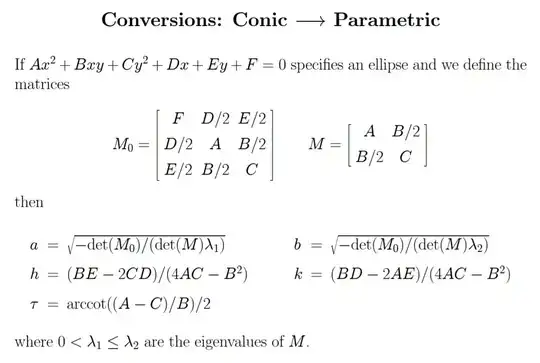Well, you could start from an ellipse in canonical position and apply a rotation and translation to it (obtaining the equations in the Wikipedia article on ellipses) and solve the resulting system, but each of the interesting pieces can be worked out independently.
One method of computing the center of an ellipse from its general conic equation is described in this question and the method is explained in the answers. Alternatively, the center is the pole of the line at infinity, so its homogeneous coordinates are given directly by the expression $M_0^{-1}(1,0,0)^T$, which you then have to dehomogenize by dividing through by the first element of the resulting vector to obtain the inhomogeneous Cartesian coordinates $(h,k)$.
Translation to the center eliminates the linear terms in the general equation but doesn’t affect the quadratic part, so the translated equation is $Ax'^2+Bx'y'+Cy'^2+F'=0$ with associated matrix $$M_0' = \begin{bmatrix}F'&0&0\\0&A&\frac B2\\ 0&\frac B2&C\end{bmatrix}.$$ Since translation doesn’t change the determinant, we can see that $F' = \det(M_0)/\det(M)$.
The principal axis theorem tells us that, for an ellipse with equation $ax^2+bxy+cy^2=1$, the major and minor axes of the ellipse are given by eigenvectors of the matrix $$\begin{bmatrix}a&\frac b2\\\frac b2&c\end{bmatrix}$$ and its semiaxis lengths are the reciprocal square roots of its eigenvalues. If the ellipse is non-degenerate, $F'=0$ and we can divide through by $-F$ to put the translated equation into the required form. Then, if $\lambda_1$ and $\lambda_2$ are the eigenvalues of $M'$ the half-axis lengths of our ellipse are $\sqrt{-F/\lambda_i}$.
You could go through some tedious algebra to work out the eigenvectors of $M$ and extract an angle $\tau$ from them, but there’s a more direct way. We want to find an angle $\tau$ such that a rotation of $M$ through $-\tau$ eliminates the cross term. Expanding $$\begin{bmatrix}\cos\tau&\sin\tau\\-\sin\tau&\cos\tau\end{bmatrix} \begin{bmatrix}A&\frac B2\\\frac B2&C\end{bmatrix} \begin{bmatrix}\cos\tau&-\sin\tau\\\sin\tau&\cos\tau\end{bmatrix}$$ and setting the upper-left element to $0$ yields the equation $$B\cos2\tau+(C-A)\sin2\tau=0.$$
